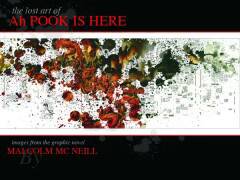
- Afhalen na 1 uur in een winkel met voorraad
- Gratis thuislevering in België vanaf € 30
- Ruim aanbod met 7 miljoen producten
- Afhalen na 1 uur in een winkel met voorraad
- Gratis thuislevering in België vanaf € 30
- Ruim aanbod met 7 miljoen producten
The Lost Art of Ah Pook Is Here
Images from the Graphic Novel
Malcolm McNeill, William BurroughsOmschrijving
In 1970, William S. Burroughs and artist Malcolm McNeill began a small collaborative project on a comic entitled The Unspeakable Mr. Hart, which appeared in the first four issues of Cyclops, England's first comics magazine for an adult readership. Soon after, Burroughs and McNeill agreed to collaborate on a book-length meditation on time, power, and control, and corruption that evoked the Mayan codices and specifically, the Mayan god of death, Ah Pook. Ah Pook is Here was to include their character Mr. Hart, but stray from the conventional comics form to explore different juxtapositions of images and words.
Ah Pook was never finished in its intended form. In a 1979 prose collection that included only the words from the collaboration, Ah Pook is Here and Other Texts (Calder, 1979), Burroughs explains in the preface that they envisioned the work to be "one that falls into neither the category of the conventional illustrated book nor that of a comix publication." Rather, the work was to include "about a hundred pages of artwork with text (thirty in full-color) and about fifty pages of text alone." The book was conceived as a single painting in which text and images were combined in whatever form seemed appropriate to the narrative. It was conceived as 120 continuous pages that would 'fold out.' Such a book was, at the time, unprecedented, and no publisher was willing to take a chance and publish a "graphic novel."
However, Malcolm McNeill created nearly a hundred paintings, illustrations, and sketches for the book, and these, finally, are seeing the light of day in The Lost Art of Ah Pook. (Burroughs' text will not be included.) McNeill himself is an exemplary craftsman and visionary painter whose images have languished for over 30 years, unseen. Even in a context divorced from the words, they represent a stunning precursor to the graphic novel form to come. Sara J. Van Ness contributes an historical essay chronicling the long history of Burroughs' and McNeill's work together, including its incomplete publishing history with Rolling Stone's Straight Arrow Press, the excerpt that ran in Rush magazine, and the text that was published without pictures.
Specificaties
Betrokkenen
- Auteur(s):
- Uitgeverij:
Inhoud
- Aantal bladzijden:
- 168
- Taal:
- Engels
Eigenschappen
- Productcode (EAN):
- 9781606994450
- Verschijningsdatum:
- 9/11/2012
- Uitvoering:
- Hardcover
- Formaat:
- Genaaid
- Afmetingen:
- 337 mm x 260 mm
- Gewicht:
- 1587 g

Alleen bij Standaard Boekhandel
Beoordelingen
We publiceren alleen reviews die voldoen aan de voorwaarden voor reviews. Bekijk onze voorwaarden voor reviews.











